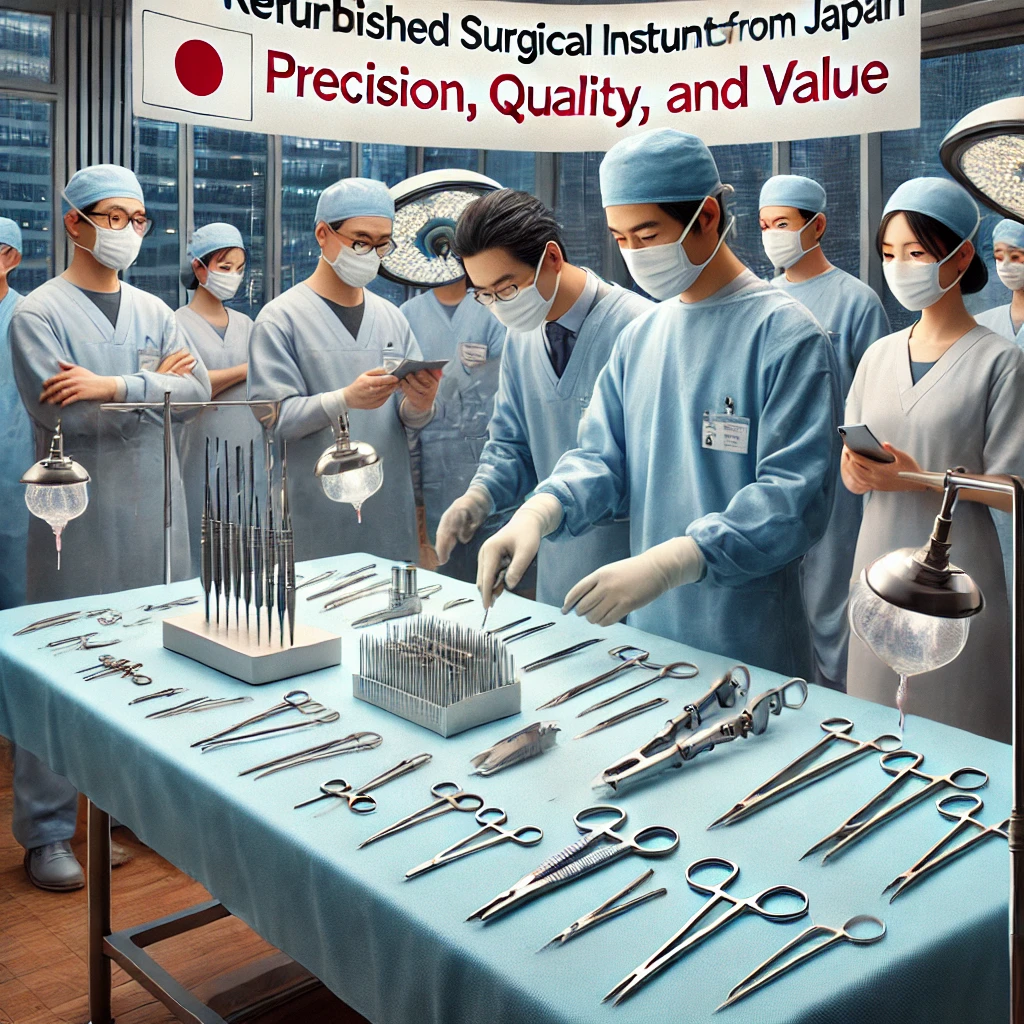

Refurbished Surgical Instruments from Japan: Precision, Quality, and Value
Japan is globally celebrated for its technological prowess, meticulous craftsmanship, and unwavering commitment to quality. These attributes extend seamlessly into the realm of medical technology, where Japanese surgical instruments have earned a reputation for precision and durability. However, the high cost of brand-new Japanese medical equipment can be a barrier for many healthcare providers, especially in resource-constrained settings. This is where refurbished surgical instruments from Japan come into play, offering an affordable yet reliable alternative without compromising on performance. This article delves into the world of refurbished surgical instruments from Japan, exploring their benefits, the refurbishment process, their role in global healthcare, and why they represent a smart investment for medical facilities worldwide.
The Legacy of Japanese Surgical Instruments
Japan’s dominance in surgical instrument manufacturing is rooted in its cultural emphasis on precision and innovation. Companies like TAKAYAMA Instrument, Inc., Fuji Flex, and larger conglomerates such as Terumo and Shimadzu have set the standard for high-quality medical tools. These instruments—ranging from microsurgical forceps to advanced laparoscopic devices—are prized for their ergonomic design, sharpness, and longevity. Crafted from premium materials like Japanese stainless steel and titanium, they embody the nation’s monozukuri philosophy, which translates to “the art of making things” with excellence.
However, the premium quality of these instruments often comes with a steep price tag, making them inaccessible for smaller clinics, developing nations, or budget-conscious hospitals. Refurbished surgical instruments bridge this gap, delivering the same Japanese precision at a fraction of the cost. By restoring used or surplus equipment to near-original condition, refurbishment ensures that healthcare providers worldwide can access top-tier tools without breaking the bank.
What Are Refurbished Surgical Instruments?
Refurbished surgical instruments are pre-owned medical tools that have undergone a rigorous process of inspection, repair, cleaning, and testing to restore them to full functionality. Unlike second-hand equipment sold “as-is,” refurbished instruments meet stringent quality standards, often backed by warranties from reputable suppliers. In Japan, this process is particularly meticulous, reflecting the country’s high standards in both manufacturing and healthcare.
The refurbishment process typically begins with sourcing instruments from hospitals, clinics, or manufacturers with excess inventory. These tools may have been lightly used, returned, or retired due to upgrades. Skilled technicians then disassemble, clean, and sterilize each piece, replacing worn components like blades or springs as needed. The instruments are tested for precision, durability, and safety before being repackaged for resale. In Japan, this process often leverages advanced technology and adheres to strict regulations, such as the Pharmaceutical and Medical Device Act (PMD Act), ensuring that refurbished products are as reliable as their new counterparts.
Benefits of Choosing Refurbished Japanese Surgical Instruments
-
- Cost-Effectiveness
The most immediate advantage of refurbished surgical instruments is their affordability. New Japanese instruments can cost thousands of dollars, whereas refurbished versions are typically priced at 30-70% less. This savings allows healthcare facilities to allocate resources to other critical areas, such as staff training or patient care, without sacrificing quality.
- Cost-Effectiveness
-
- Uncompromised Quality
Japan’s reputation for excellence extends to its refurbishment industry. Companies like Bond Japan and Intermedical Co., Ltd., specialize in restoring used medical equipment, ensuring that refurbished instruments retain the precision and reliability of their original design. For example, a refurbished TAKAYAMA microsurgical forceps or a Fuji Flex laparoscopic tool can perform with the same accuracy as a new one, thanks to expert refurbishment techniques.
- Uncompromised Quality
-
- Sustainability
In an era where environmental responsibility is paramount, refurbishing surgical instruments aligns with sustainable healthcare practices. By extending the lifecycle of these tools, refurbishment reduces medical waste and the demand for raw materials like steel and titanium. Japanese firms, known for their eco-conscious innovations, often incorporate sustainable practices into the refurbishment process, further enhancing its appeal.
- Sustainability
-
- Access to Advanced Technology
Refurbished instruments provide access to cutting-edge Japanese technology that might otherwise be out of reach. For instance, a refurbished endoscopic system from Fujifilm or a robotic surgery tool from Medicaroid can bring state-of-the-art capabilities to smaller facilities, leveling the playing field in global healthcare.
- Access to Advanced Technology
-
- Warranty and Support
Reputable Japanese suppliers often offer warranties and after-sales support for refurbished instruments, providing peace of mind to buyers. This assurance is particularly valuable in surgical settings, where equipment failure is not an option.
- Warranty and Support
The Refurbishment Process: A Japanese Standard of Excellence
The refurbishment of surgical instruments in Japan is a highly specialized process that mirrors the precision of the country’s manufacturing sector. It typically involves several key steps:
-
- Sourcing: Instruments are acquired from trusted sources, such as Japanese hospitals upgrading their equipment or manufacturers with surplus stock.
-
- Inspection: Each tool is examined for wear, damage, or defects, with a focus on critical components like cutting edges and hinges.
-
- Restoration: Worn parts are repaired or replaced using OEM (original equipment manufacturer) components to maintain compatibility and performance.
-
- Sterilization: Instruments undergo rigorous cleaning and sterilization to eliminate any risk of contamination, adhering to Japan’s stringent healthcare standards.
-
- Testing: Functionality, precision, and safety are verified through rigorous testing, often using advanced calibration tools.
-
- Certification: Once approved, the instruments are certified as refurbished and packaged with detailed documentation.
This meticulous approach ensures that refurbished instruments meet the same high standards as new ones, making them a viable option for surgeons worldwide.
Applications in Global Healthcare
Refurbished Japanese surgical instruments are making a significant impact across diverse healthcare settings. In developing countries, where budgets are tight, these tools enable clinics to perform complex procedures like orthopedic surgeries or cardiovascular interventions. In wealthier nations, they offer cost-effective backups or supplements to existing equipment, enhancing operational flexibility in hospitals and surgical centers.
For example, a refurbished Japanese bone saw or scalpel can be a lifeline in rural clinics, while a restored MRI-compatible titanium forceps can support delicate neurosurgery in urban hospitals. During global health crises, such as the COVID-19 pandemic, refurbished ventilators and diagnostic tools from Japan have helped meet urgent demands, showcasing their versatility and reliability.
Challenges and Considerations
While refurbished surgical instruments offer numerous advantages, buyers should exercise due diligence. Not all refurbishers adhere to the same standards, and subpar processes can compromise safety. To mitigate risks, healthcare providers should source from reputable Japanese suppliers with a proven track record, such as Bond Japan or Intermedical, and verify certifications. Additionally, understanding the instrument’s history—such as its prior use and refurbishment extent—can inform purchasing decisions.
Why Japan Stands Out in the Refurbished Market
Japan’s refurbished surgical instruments stand apart due to the country’s unique blend of technological expertise, quality control, and regulatory oversight. Unlike some markets where refurbishment may be a haphazard process, Japan’s industry is supported by a culture of accountability and precision. Suppliers often collaborate with original manufacturers, ensuring that refurbished products align with initial design specifications. This synergy, combined with Japan’s global reputation, makes its refurbished instruments a trusted choice.
Conclusion
Refurbished surgical instruments from Japan offer a compelling solution for healthcare providers seeking quality, affordability, and sustainability. By combining the nation’s legendary precision with cost-effective refurbishment, these tools democratize access to advanced medical technology. Whether equipping a rural clinic or enhancing a high-tech surgical suite, they deliver exceptional value without compromise. As the demand for sustainable and accessible healthcare grows, Japan’s refurbished surgical instruments are poised to play an increasingly vital role, proving that excellence need not come at an exorbitant price.
Add a comment Cancel reply
Related posts


Regulatory Compliance for Refurbished Medical Devices

New vs. Refurbished Medical Devices: Making the Decision

The Unmatched Precision of Japanese Medical Technology
Japan Address
COMFYS JAPAN LLC, R Cube Aoyama 3rd Floor, 1-3-1 Kita-Aoyama, Minato-ku, Tokyo 107-0061,Japan
Africa Address
Comfys International Limited KP Offices, Suite 26 Milimani, Nairobi, KENYA




